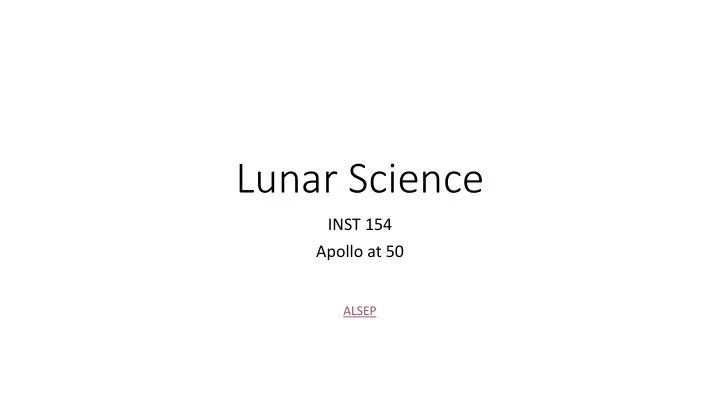

Lunar Science INST 154 Apollo at 50 ALSEP
Chronology • June-August 1962 Iowa Space Science Board Summer Study Group • December 1963 Sonnet Report on Apollo Science • July 1964 First successful Ranger mission • October 1964 Scientist Astronaut applications invited • June-July 1965 Woods Hole Space Science Board Conference • July 1965 Falmouth Lunar Science Conference • July 1965 Apollo Site Selection Board established • February 1966 Office of Space Science decision on experiments • May 1966 First successful Surveyor mission • August 1966 First successful Lunar Orbiter mission • July 1969 First Apollo lunar landing • September 1977 Termination of ALSEP monitoring
The Sonnet Report (1963) • Office of Manned Space Flight specifically requested input on: • Number of missions • Background of crew members • Duration of lunar stay • Payload (weight and power) • Mobility (e.g., surface vehicle) • Space suit capabilities • Additional input was requested on: • Landing site selection • Need for a soft-landed supply vehicle
Reasons for Scientific Inquiry • Advancing human knowledge • Providing a scientific basis for engineering • Supporting operational activities
Selection Criteria • Scientific importance • Feasibility • Particular to the Moon • Best carried out with human assistance
Scientific Disciplines • In-Situ: • Geology (mapping, sampling, drilling, …) • Solid body geophysics (heat flow, radioactivity, seismology, gravity, …) • Atmosphere (density, scattering, …) • Plasma physics (electric field, magnetic field, plasma flows, …) • Surface physics (bombardment, dust structure, dust transport, electrostatic, …) • Astronomy (ultraviolet, radio, …) • Sample analysis: • Geochemistry • Biology
Scientific Activities on the Moon • Observation of natural phenomena • Collection of material • Geological samples • Biological samples • Emplacement of long-term monitoring equipment
Operational Needs • Spacesuit mobility • Necessary for sampling and emplacement • High-resolution maps • Based on orbital photography with resolution of less than 3 feet • Precise positioning, helmet-mounted TV, high resolution camera • To maximize scientific return given limited time • Multi-day surface stays with multiple moonwalks • Characterizing one square mile on earth takes a week • Landing site selection • Any site for the first landing, then guided by scientific interest • Lunar rover • To reconcile landing risk with scientifically interesting sites
Scientist Astronauts • One on each (initially 3-person) lunar landing crew • Optimally, a combined background in geology and geophysics • Continuing involvement in research • Based at a research institute near Manned Spacecraft Center • Hosting visiting scientists • Contribute to scientific training of pilot astronauts • Less than 50% of time spent on flight training (except short periods)
Astronaut Group 4 (June 1965) Physics Physics Medicine Medicine Geology Physics
Astronaut Group 6 (1967) Medicine Geochemistry Medicine Engineer Astronomy Astronomy Physics Astronomy Medicine Engineer Biochemistry
NASA and the National Reconnaissance Office • Lunar Orbiter • Apollo site certification • Based on Air Force Samos program design
NASA and the National Reconnaissance Office • Lunar Orbiter • Apollo site certification • Based on Air Force Samos program design • Lunar Mapping and Survey System (“Upward”) • Backup plan for Apollo site certification • KH-7 Gambit-1 camera (2 ft resolution on Earth)
Discussion Groups • Sonnet Report (“Report of the Ad Hoc Working Group on Apollo Experiments and Training on the Scientific Aspects of the Apollo Program”) • The first try to nail down what Apollo should do on the Moon • Compton chapter 3 (“Apollo’s Lunar Exploration Program”) • An explanation of what happened after the Sonnet Report • FETM episode 10 (“Galileo was Right”) • A dramatization of scientific training for an Apollo mission • NRO Draft (“Project Upward: The NRO and NASA”) • Reuse of spy satellite technology in the Apollo program
Discussion Groups • FETM episode 2 (“Apollo One”) • A dramatization of the effects of the fire • Cox Chapter 14 (“Did He Say Fire?”) • The engineers’ view of the fire • Report of the Apollo 204 Review Board • Complete history, timeline and analysis of the accident • Chaikin Chapter 1 (“Fire in the Cockpit”) • The astronaut’s view of the fire
Recommend
More recommend